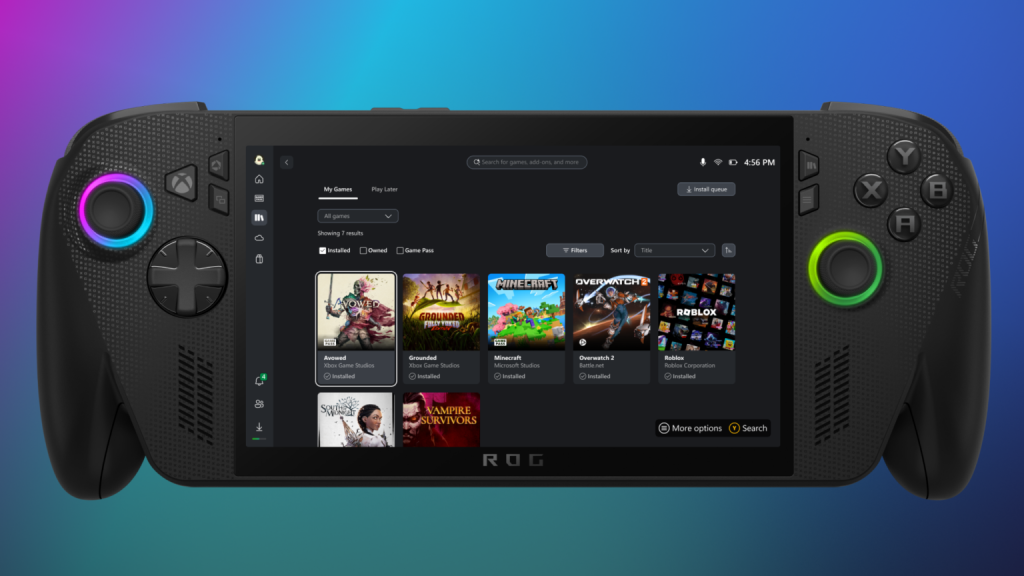In a significant move for PC gaming, Microsoft is currently piloting an innovative new feature for the Xbox app that aims to aggregate games from multiple third-party storefronts into a single, user-friendly interface. This development, announced in a recent Xbox blog post, marks a concerted effort by the tech giant to enhance the gaming experience for PC players, enabling them to manage their installed games more efficiently in one location. The feature is set to be available for a select group of users within the Xbox Insider program this week, with plans to roll it out further, starting with the newly launched ROG Xbox Ally and Ally X handheld gaming devices later this year [Xbox Blog].
Feature Highlights
The aggregation feature promises to streamline the gaming library experience by allowing users to view all their installed titles from various platforms, provided those games are installed via supported third-party stores. Initially, Microsoft has confirmed compatibility with Battle.net, Electronic Arts (EA), and titles from Riot Games available through Xbox Game Pass. While the integration of EA and Riot Games is already partially realized through Game Pass, the introduction of Battle.net integration opens the door for a wider range of popular titles to be included as well. Microsoft has indicated that additional support for other storefronts, including Steam, Epic Games Store, and GOG, is likely on the horizon.
Impact on the Gaming Ecosystem
This new aggregated library feature is poised to change the landscape for PC gamers substantially. By potentially enabling players to manage their entire game collection from a single application, Microsoft is bringing a console-like experience to the PC gaming realm. Traditionally, players have needed to navigate separate clients for each game library, which can be cumbersome and time-consuming. The Xbox app aims to eliminate this hassle, consolidating everything under one roof.
The convenience of an integrated platform may draw in more users to the Xbox ecosystem, particularly those who have hesitated to switch from established platforms like Steam or Epic Games. According to [Statista], Steam currently boasts over 130 million active users, underscoring the formidable competition Microsoft faces in this space. However, if successful in offering unified access to a wider array of games, Microsoft could see an uptick in users transitioning to or incorporating the Xbox app into their gaming habits.
Strategic Shift Towards Services
The rollout of this aggregation feature is a clear indication of Microsoft’s strategic pivot towards transforming the Xbox brand from a traditional console-focused identity to one that emphasizes services and accessibility. This shift has been in motion since the launch of Xbox Game Pass, which has drawn a strong subscription base across both console and PC platforms. The recent introduction of Xbox-branded handheld PCs like the ROG Ally showcases Microsoft’s flexibility and willingness to adapt to evolving gaming trends and hardware demands.
Moreover, this approach is aligned with Microsoft’s broader vision for Windows 11, which has seen several Xbox-specific enhancements integrated into the operating system over the past few years. By prioritizing Windows optimization for third-party handhelds instead of developing an in-house handheld console, Microsoft is positioning itself to leverage existing hardware innovations while still providing an enriched gaming experience.
Looking Ahead: Community Expectations and Future Potential
As the new aggregated library feature is set to begin its rollout with the ROG handhelds during the upcoming holiday season, excitement within the gaming community is palpable. While Microsoft has not announced an exact date for the mainstream launch of the feature, many gamers expect that full support will emerge by the end of 2026, further augmenting the Xbox app’s utility and reach.
In addition to increasing user engagement, this feature may also alter how third-party developers approach their distribution strategies. The consolidation of gaming libraries could encourage more partnerships between Microsoft and other game publishers, fostering an environment where developers actively seek to list their titles across multiple storefronts to gain visibility and market share.
With these developments, Microsoft is not only reshaping its own gaming ecosystem but also positioning itself as a key player in the broader industry landscape. As the company continues to refine and expand these new features, it will be crucial to monitor how gamers respond and how the competitive dynamics within the gaming market evolve over time.
Quick Reference Table
| Feature | Description |
|---|---|
| Aggregated Library | View all installed games from third-party stores in one app |
| Supported Stores | Battle.net, EA, Riot Games (via Game Pass) |
| Future Stores | Expected support for Steam, Epic Games, GOG |
| Target Devices | Initially launching with ROG Ally handhelds |
| Mainstream Launch | Expected by end of 2026 |
For those interested in the latest updates on this and other topics, make sure to follow reputable gaming news sources and keep an eye on Microsoft’s future announcements.

